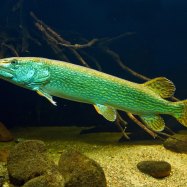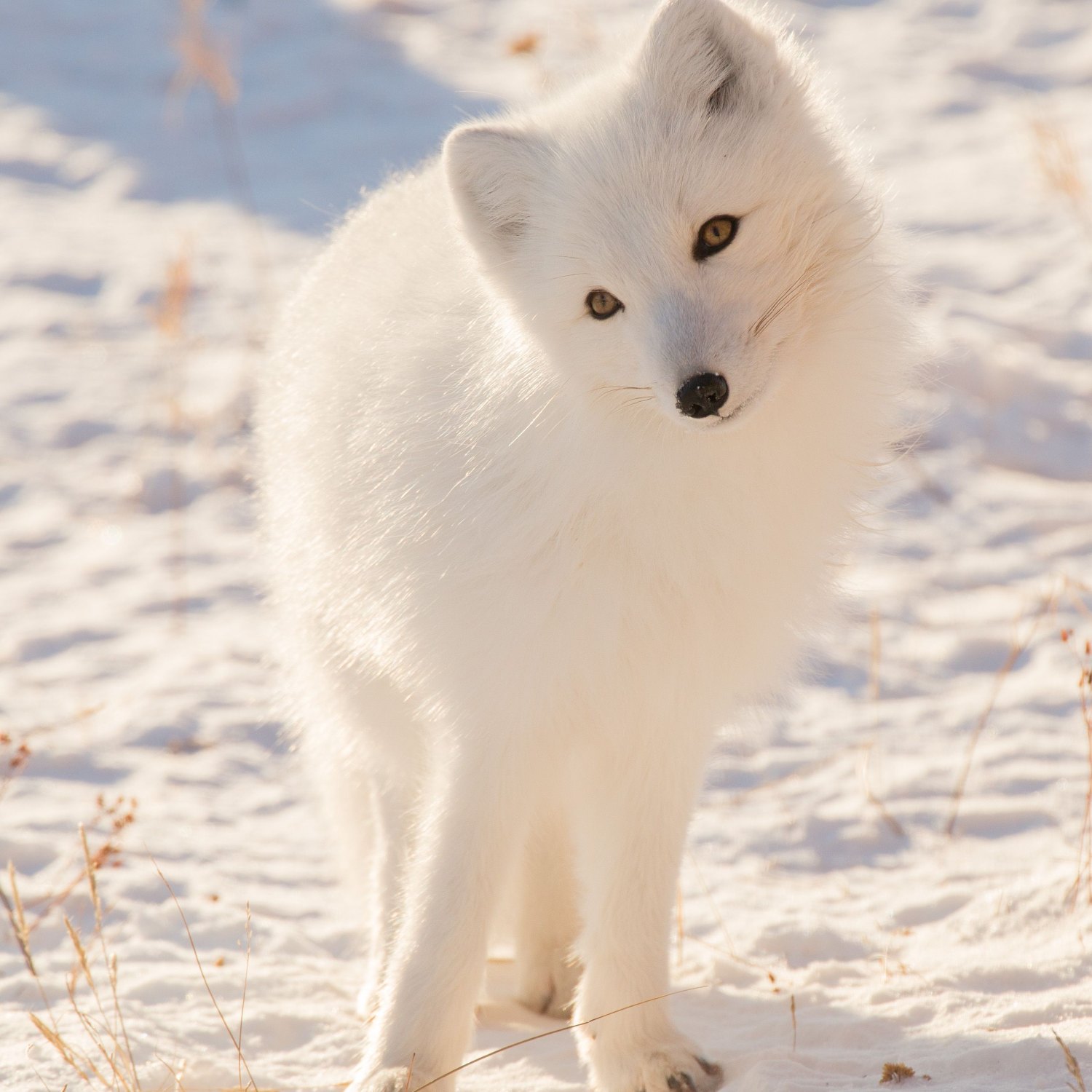
Arctic Fox
45-68 cm
The arctic fox is a small and compact animal that can be found in the Arctic Circle. This member of the Canidae family has a length of 45-68 cm and is known for its striking white fur, which helps it blend into its snowy surroundings. Despite their cute appearance, these foxes are fierce hunters and can survive in the harsh arctic conditions.
Animal Details Summary:
Common Name: Arctic Fox
Kingdom: Animalia
Habitat: Tundra and Arctic regions
The Amazing Adaptations of the Arctic Fox: Surviving the Harsh Tundra
The icy wilderness of the tundra and Arctic regions is home to some of the most resilient and adaptable creatures on earth. Among them is the Arctic fox, also known as the white fox or polar fox. With its distinctive white coat and small, compact body, the Arctic fox camouflages perfectly into its frozen environment. But there is more to this species than meets the eye Arctic Fox. Let's dive into the remarkable features and adaptations of the Arctic fox that make it one of the most fascinating animals on the planet.The Basics: Taxonomy and Distribution
The Arctic fox, with the scientific name Vulpes lagopus, belongs to the Animalia kingdom and the Chordata phylum. They are classified under the Mammalia class and the Carnivora order. As part of the Canidae family, they are closely related to other foxes, wolves, and dogs.This arctic creature's natural habitat is the tundra and Arctic regions of the Northern Hemisphere. They can be found in countries such as Greenland, Iceland, Canada, Russia, Norway, and Alaska. Within this vast landscape, they primarily reside in the Arctic Circle, where temperatures can drop as low as -58°F (-50°C).
The Omnivorous Arctic Fox: Surviving on Limited Resources
Most animals in the Arctic have a specialized diet that includes only plants, meat, or fish. However, the Arctic fox is an omnivore, meaning it can survive on both plant and animal sources Alaskan Husky. Although they primarily consume lemmings (small rodents), they are opportunistic hunters with a diverse diet. They will eat whatever is available in their environment, from birds and eggs to berries and carrion.The Arctic fox's ability to adapt its diet to various food sources makes it a successful predator in extreme conditions. They also have an outstanding sense of smell, which helps them locate hidden food sources under the snow. This unique trait allows them to survive in an environment where resources are scarce.
The Ultimate Survivor: Remarkable Adaptations
Living in the harsh Arctic conditions requires exceptional adaptations. The Arctic fox has evolved to withstand the extreme cold, limited food sources, and other challenges that come with its environment. Its physical features and behaviors allow it to thrive in an environment that would be challenging for many other species.Camouflaging Coats
One of the most noticeable adaptations of the Arctic fox is its seasonal coat change. In the winter, their fur turns completely white, blending in with the snow-covered landscape. This camouflage helps them evade predators and sneak up on their prey. As the seasons change and snow melts, their fur gradually turns brown or grayish-brown, matching the tundra's color during summer. This natural camouflage not only helps with hunting and avoiding predators but also provides warmth for the fox in the frigid Arctic weather.
Compact Body Size
The Arctic fox typically has small and compact bodies, measuring 45-68 cm in length. Their size allows them to conserve body heat in the harsh climate. They also have short ears and limbs, minimizing heat loss in these high surface areas. Additionally, their paws are densely covered in fur, acting as natural snowshoes that prevent sinking into the snow and aiding in hunting.
Digging and Huddling
During the frigid winters, when temperatures can reach -94°F (-70°C), the Arctic fox takes refuge by digging into the snow. They use their strong claws to burrow down to the ground, creating a cozy den where they can stay warm and safe. When several foxes dig and curl up together, it creates an insulated shelter that helps them retain heat. This behavior is called huddling, where they can keep each other warm, even in the most brutal conditions.
Adaptations for the Hunt
The long, bushy tail of the Arctic fox is not just for show; it serves several purposes. It provides balance when running and jumping over snow, and it can also wrap around their face and paws to keep them warm. Additionally, the tails act as a signaling tool, communicating with other foxes, especially during the breeding season.
Their keen sense of smell and sharp hearing also aid the Arctic fox in hunting. They can detect prey moving under the snow and hear their movements, thanks to their large ears. They have incredible agility, able to chase and catch prey 2-3 times their size. These adaptations make the Arctic fox a successful predator, even in an environment where resources are scarce.
A World of Survival: Threats to the Arctic Fox
As with all it's cold-dwelling counterparts, the Arctic fox faces numerous threats that challenge its survival. The most significant danger is the changing climate, leading to reduced ice coverage, unpredictable weather patterns, and a decline in prey species. The reduction in sea ice also affects the Arctic fox's main competitor and predator, the polar bear, leading to increased competition for resources. Climate change also affects the fox's adaptation to its winter coat, as the snow cover decreases, making it less effective for camouflage.Human activities have also had a devastating impact on the Arctic fox population. They are hunted for their fur, disrupted by oil and gas exploration, and suffer from the changing landscape due to human infrastructure development. Conservation efforts and protection of their habitats are crucial in ensuring the Arctic fox's survival.
The Arctic Fox: A Symbol of Adaptability
The Arctic fox is the ultimate survivor, thriving in a harsh and ever-changing environment. Its incredible adaptations, from its camouflaging coats to its ability to huddle and burrow, have made it one of the most resilient creatures on the planet. As we continue to learn more about this remarkable animal, we are reminded of our role in protecting the fragile ecosystems and the animals that call them home.

Arctic Fox
Animal Details Arctic Fox - Scientific Name: Vulpes lagopus
- Category: Animals A
- Scientific Name: Vulpes lagopus
- Common Name: Arctic Fox
- Kingdom: Animalia
- Phylum: Chordata
- Class: Mammalia
- Order: Carnivora
- Family: Canidae
- Habitat: Tundra and Arctic regions
- Feeding Method: Omnivorous
- Geographical Distribution: Arctic regions of the Northern Hemisphere
- Country of Origin: Greenland, Iceland, Canada, Russia, Norway, and Alaska
- Location: Arctic Circle
- Animal Coloration: White in winter, brown or grayish-brown in summer
- Body Shape: Small, compact
- Length: 45-68 cm
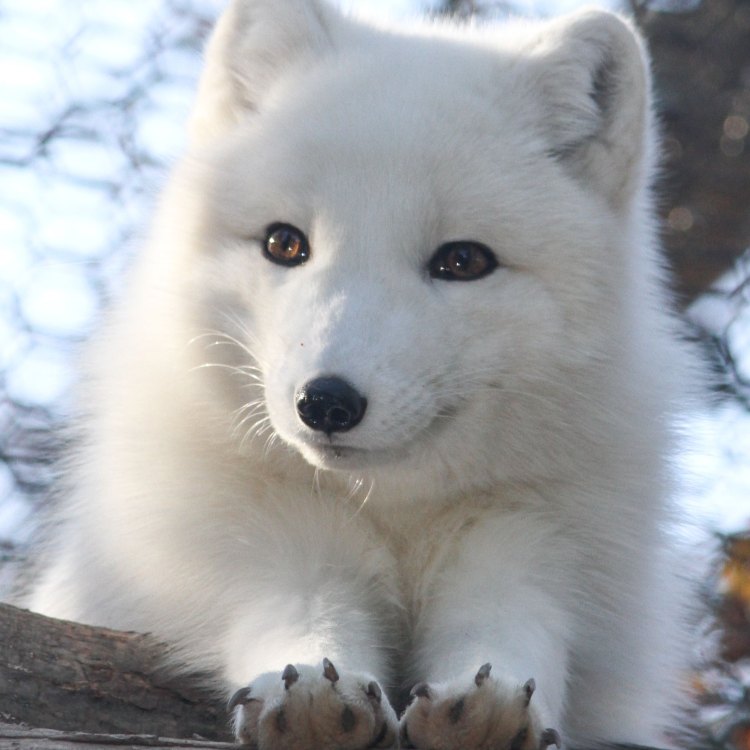
Arctic Fox
- Adult Size: 2.5-9 kg
- Average Lifespan: 3-6 years in the wild, up to 10 years in captivity
- Reproduction: Monoestrous
- Reproductive Behavior: Mating occurs in late winter or early spring
- Sound or Call: Barking, howling, screaming
- Migration Pattern: Some individuals migrate short distances
- Social Groups: Solitary or pair-bonded
- Behavior: Nocturnal, territorial
- Threats: Climate change, habitat loss, predation
- Conservation Status: Least Concern
- Impact on Ecosystem: Important role in the Arctic food chain
- Human Use: Fur trapping
- Distinctive Features: Thick fur, bushy tail, small ears
- Interesting Facts: Can survive in temperatures as low as -50°C
- Predator: Polar bears, wolves
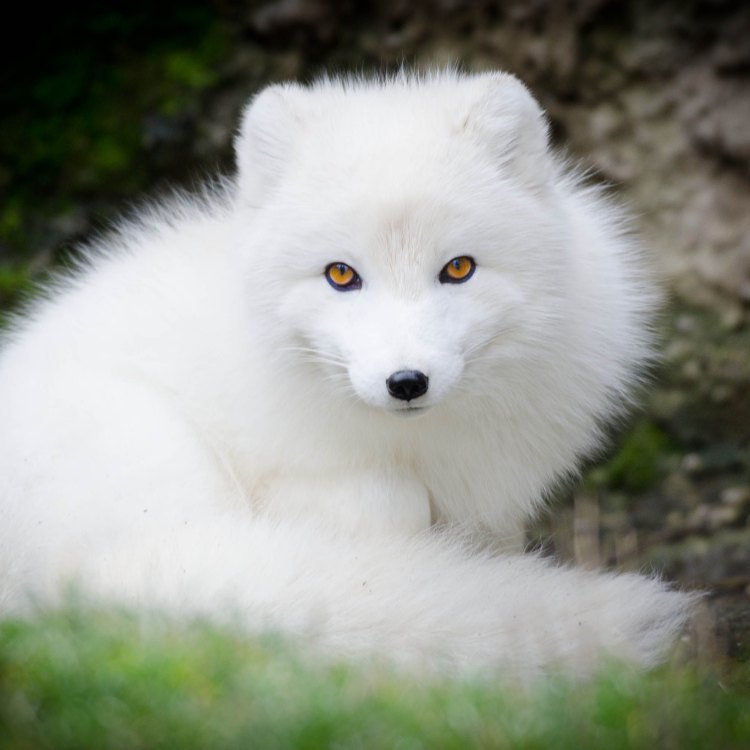
Vulpes lagopus
The Resilient Creatures of the Frozen North: The Arctic Fox
The Arctic tundra is known for its harsh and unforgiving conditions, with temperatures that can plunge well below freezing and terrain that can be difficult to navigate. Despite these challenges, there are creatures that have adapted and flourished in this frozen world. Among them is the Arctic fox, a species that is uniquely suited to its Arctic home.A Look at the Arctic Fox
The Arctic fox, also known as the snow fox or polar fox, is a small mammal that inhabits the Arctic regions of North America, Canada, Greenland, and parts of Europe and Asia PeaceOfAnimals.Com. It is one of the smallest members of the canid family, weighing in at just 2.5-9 kg. Despite its small size, the Arctic fox is a formidable survivor, able to thrive in some of the coldest and harshest environments on the planet.Surviving Against the Odds
The Arctic fox's resilience is evident in its average lifespan of 3-6 years in the wild, and even longer in captivity, with some individuals surviving up to 10 years. This feat is quite impressive considering the harsh conditions of the Arctic, where food can be scarce and temperatures can drop to -50°C.One reason for the Arctic fox's survival is its ability to adapt to seasonal changes. Unlike other fox species, the Arctic fox is monoestrous, meaning it only goes into heat once a year. Mating occurs in late winter or early spring, with females giving birth to a litter of 5-8 pups in the summer.
During the mating season, the male Arctic fox's vocalizations can be heard in the tundra, ranging from barks and howls to high-pitched screams Agouti. These sounds serve as a way to communicate with potential mates and establish territory.
Masters of Migration
While some individuals migrate short distances in search of food, the Arctic fox is not known for extensive migrations like other Arctic animals such as caribou or birds. However, it does have the ability to travel long distances in harsh conditions, which is a testament to its survival skills.A Creature of Solitude
The Arctic fox is a solitary animal, only socializing during the mating season or when raising young. Some individuals form pair bonds with a mate, staying together for multiple mating seasons. However, even in these pair bonds, each fox maintains a certain level of independence.As a primarily nocturnal animal, the Arctic fox spends its days sleeping in a den or out of sight in areas with good cover. At night, it becomes active, using its excellent sense of smell and hearing to hunt for prey such as lemmings, voles, and Arctic hares.
Threats to Survival
The Arctic fox may be a resilient species, but it still faces threats to its survival. One of the biggest threats is climate change, which is causing changes to the Arctic tundra and making it difficult for the fox to adapt. Melting sea ice, longer periods of warm weather, and increased rainfall can all have a negative impact on the Arctic fox's habitat and food sources.Another threat to the Arctic fox is habitat loss due to human activities such as oil and gas exploration and development. This not only destroys the fox's habitat but also brings pollution and other disturbances that can directly harm the animals and disrupt their natural behaviors.
While the Arctic fox is not a major target of predators, it does have some natural enemies such as polar bears and wolves. These predators can have a significant impact on the Arctic fox's population, especially in areas where food is scarce.
Conservation Efforts
Despite these threats, the Arctic fox is currently listed as Least Concern on the International Union for Conservation of Nature (IUCN) Red List. This means that the species is not currently at risk of extinction, but its population is still monitored and conservation efforts are ongoing.One of the reasons the Arctic fox has been successful in maintaining its population is its crucial role in the Arctic food chain. As a predator of rodents, the Arctic fox helps to control their populations and maintain balance in the ecosystem. Without this predator-prey relationship, the entire Arctic food chain could be disrupted.
A Part of Human History
The Arctic fox has also played a significant role in human history, particularly in indigenous cultures. The Inuit people of North America and the Sami people of Scandinavia have long used the Arctic fox's fur for a variety of purposes, including clothing, bedding, and as a trading item.Today, fur trapping is still a common use of the Arctic fox, with its thick and warm fur being highly sought after for its luxurious quality. However, stricter regulations and bans on fur imports have helped to reduce the impact of fur trapping on the Arctic fox population, making it a more sustainable practice.
The Distinctive Features of the Arctic Fox
The Arctic fox is a unique and fascinating animal, with several distinctive features that help it thrive in its harsh environment. One of the most notable features is its thick fur, which protects it from freezing temperatures and helps it to blend in with its surroundings.The Arctic fox's fur is typically white in the winter, providing excellent camouflage on the snow-covered tundra. In the summer, it turns brown or gray, allowing the fox to blend in with the rocks and vegetation. This color change is a form of camouflage known as seasonal polymorphism, and it is a crucial survival strategy for the Arctic fox.
Another distinctive feature of the Arctic fox is its bushy tail. The long, bushy tail serves several purposes. It can be used as a warm blanket when the fox curls up to sleep, as well as a balance for maneuvering over ice and snow. The fox also uses its tail to cover its nose and face during strong winds, protecting itself from frostbite.
Compared to other fox species, the Arctic fox has smaller ears, which help retain body heat in the sub-zero temperatures. The ears have a reduced size and blood flow to prevent heat loss, allowing the fox to maintain its body temperature in the coldest weather.
Fun Facts About the Arctic Fox
As if its resilience and unique features weren't enough, the Arctic fox also has some interesting facts that make it an even more impressive creature of the frozen north.The Arctic fox has a low surface area to volume ratio, which helps it retain heat in the cold temperatures. This is due to its relatively short legs and compact body, allowing it to conserve energy and stay warm in the harsh Arctic climate.
Despite being a mammal, the Arctic fox can survive in temperatures as low as -50°C. This is made possible by its thick fur, efficient metabolism, and adaptations such as a dense undercoat that traps body heat.
Some individuals of the blue morph population of Arctic foxes have coats that turn blue-gray in the winter rather than the usual white or brown. This unique coloration is believed to be a result of a genetic mutation that has helped these foxes to blend in with their environment and avoid being targeted by predators.
In Conclusion
The Arctic fox may be a small and unassuming creature, but its ability to survive and thrive in one of the harshest environments on the planet is a testament to its resilience and adaptability. While facing threats from climate change and human activities, this remarkable animal continues to play a vital role in the Arctic ecosystem, making it a true symbol of strength and survival in the frozen north.So, the next time you hear a barking, howling, or screaming sound in the Arctic tundra, you can appreciate the resilience and tenacity of the Arctic fox, a master of survival in the frozen world.
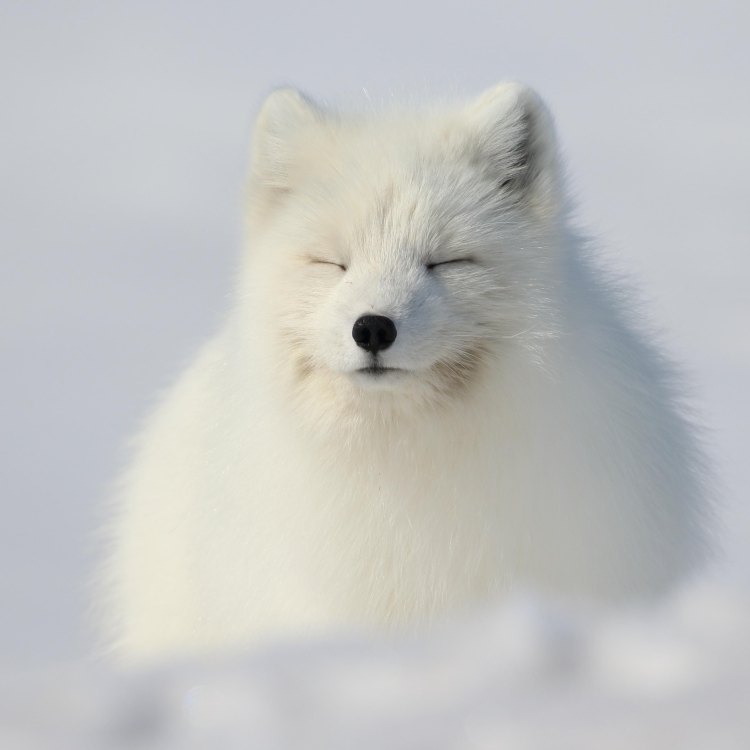
The Amazing Adaptations of the Arctic Fox: Surviving the Harsh Tundra
Disclaimer: The content provided is for informational purposes only. We cannot guarantee the accuracy of the information on this page 100%. All information provided here may change without prior notice.

